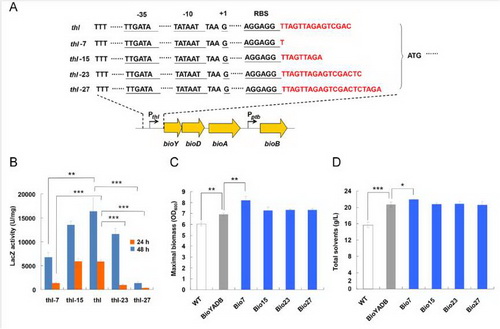Metabolic Engineering:中科院植生所姜卫红研究组发现产溶剂梭菌遗传
2月23日,国际学术期刊《Metabolic Engineering》在线发表了中国科学院上海生命科学研究院植物生理生态研究所姜卫红研究组题为“Improving the performance of solventogenic clostridia by reinforcing the biotin synthetic pathway”的研究论文。该工作揭示了细胞内生物素合成水平对于提升产溶剂梭菌发酵性能的重要性,并通过途径改造实现了菌株对该营养因子的自给,显著提高了溶剂的合成能力。
产溶剂梭菌(Solventogenic clostridia)是一类革兰氏阳性、厌氧细菌。其底物谱宽泛,能够利用糖质原料、秸秆类木质纤维原料乃至一碳气体(CO,CO2),且产物种类丰富,可天然合成多种大宗化学品及燃料。作为重要的工业微生物,产物合成效率和产量是产溶剂梭菌重要的经济性指标。
姜卫红研究组的博士研究生杨云鹏和顾阳研究员在前期产溶剂梭菌代谢调控的研究中,发现了多效调控蛋白CcpA在改善细胞性能中的“正功效”。进一步的比较转录组分析表明,生物素合成途径是其重要的作用靶点,直接影响了菌体的生长速率和产物合成能力。随后,通过对功能元件的预测和鉴定、分子改造及途径重构,有效地提高了菌体的生物素合成水平,实现了该关键营养物的自给。最终,工程菌的细胞内生物素浓度达到原始菌株的1.6倍,产物合成效率和产量均增加30%以上。此外,将该策略运用到组合代谢工程中,进一步提升了工程菌对五、六碳糖的共利用能力。上述工作为改良产溶剂梭菌提供了新思路。

生物素合成途径优化提高产溶剂梭菌发酵性能
原文链接:
Improving the performance of solventogenic clostridia by reinforcing the biotin synthetic pathway
原文摘要:
An efficient production process is important for industrial microorganisms. The cellular efficiency of solventogenic clostridia, a group of anaerobes capable of producing a wealth of bulk chemicals and biofuels, must be improved for competitive commercialization. Here, using Clostridium acetobutylicum, a species of solventogenic clostridia, we revealed that the insufficient biosynthesis of biotin, a pivotal coenzyme for many important biological processes, is a major limiting bottleneck in this anaerobe’s performance. To address this problem, we strengthened the biotin synthesis of C. acetobutylicum by overexpressing four relevant genes involved in biotin transport and biosynthesis. This strategy led to faster growth and improved the titer and productivity of acetone, butanol and ethanol (ABE solvents) of C. acetobutylicum in both biotin-containing and biotin-free media. expressionally modulating these four genes by modifying the ribosome binding site further promoted cellular performance, achieving ABE solvent titer and productivity as high as 21.9 g/L and 0.30 g/L/h, respectively, in biotin-free medium; these values exceeded those of the wild-type strain by over 30%. More importantly, biotin synthesis reinforcement also conferred improved ability of C. acetobutylicum to use hexose and pentose sugars, further demonstrating the potential of this metabolic-engineering strategy in solventogenic clostridia.
doi:10.1016/j.ymben.2016.02.006
作者:姜卫红

